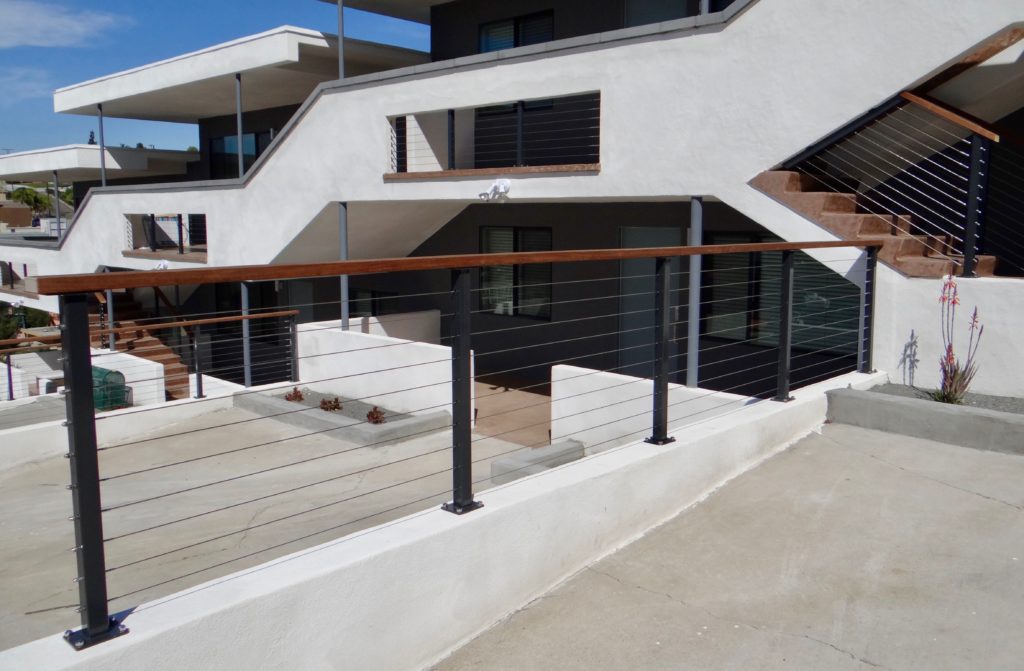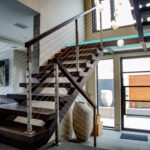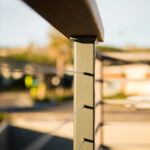
Many of the same considerations made when constructing deck railings will also apply to railing systems for retaining walls. Outdoor railings are subjected to a host of environmental and usage factors that do not apply indoors; so durability of the railing materials is very important. Additionally, the mounting style and connection types may vary greatly from an exterior wall to an interior railing system. Based on our experience and a variety of our own retaining wall projects, here are some of the most common considerations we encounter on wall mounted railing systems:
Approved Fasteners and Connections for Retaining Wall Railings
There are several wall construction methods we see quite frequently with our wall mounted cable railings. Standard CMU walls, geo grid walls, and poured concrete walls are a few of the most common wall types in California. Connections of railing posts to poured concrete and CMU (block) can be made directly with the use of approved concrete anchors or epoxied rods, where a stackable block wall may require something different. It’s important to know if the wall is engineered for a direct railing mount or if it must be cast in place. Additionally, the installer should consider where the reinforcement bars have been placed, and if there is enough room for embedment. Certain applications have required posts to be cast in concrete ground footings behind the actual wall vs. on top.
Hollow Block Walls and Masonry Fencing
On occasion we have been called out to install retrofit railings and fencing on existing block walls or masonry fences. The main difference between a masonry wall and a fence is that a masonry fence is not designed to retain earth, and therefore may be hollow or only contain sporadically filled cells.
A hollow wall doesn’t necessarily eliminate the possibility of a wall mounted connection, however railing posts should not be connected to hollow CMU block cells. A concrete block by itself is not designed do take a lateral or shear load from any railing member. Retrofit grouting of cells at the post locations may be necessary in order to make a proper connection. Many times this can be achieved by drilling holes in the existing caps and pumping high strength grout into the cells. Once the grout has cured, the railings can be safely mounted.

What are the Best Railing Systems for Retaining Walls?
Like any “what is the best?” question; preferences will play a role in the ultimate selection of the railing type; however we do believe that steel is preferential to wood when it comes to wall mounted railings. A steel framed cable railing system with a direct mechanical or poured connection will be far superior to a wooden fence or picket rail for example.
Wooden posts will require larger members in comparison to steel; and possibly stand alone brackets in order to mount on top of the wall. A steel post with a welded connection can be directly attached with wedge anchors; epoxy rods or cast directly into CMU cells with relative ease. The durability and longevity of a stainless steel cable railing system will also far surpass the wooden wall top fencing and railings. Aesthetically, modern design trends would also lean towards the clean look of cable or possibly a wall top glass railing system.
Cable Railing Products for Wall Mounted Railings
San Diego Cable Railings furnishes cable railings and glass railing systems for several of the most common retaining wall applications. Our online storefront features many stock products that can be mounted directly to new and existing walls. Many of our products are engineered, and our preferred installers have over 15 years experience installing these type of railings all over California. If you have questions about a wall mounted railing or would like an estimate please give us a call at 844-277-7327 or visit the quote request page.




